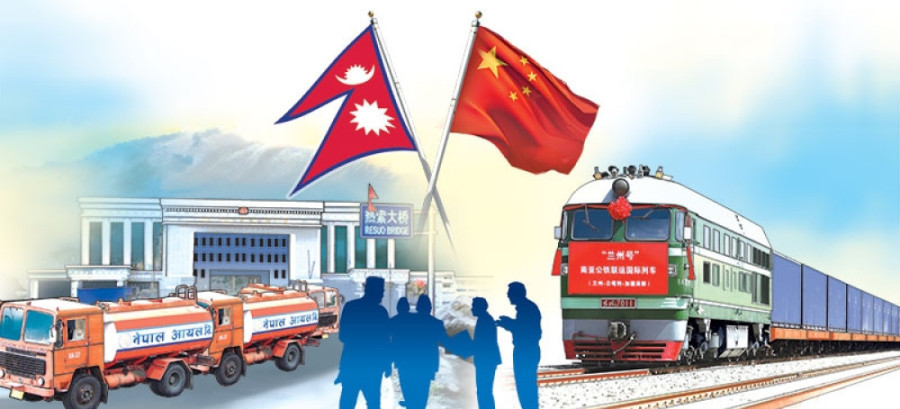Columns
Time to synchronise
It is unfair to accuse China of setting up a debt trap simply because it is involved in financing them.
Gao Liang
Prime Minister Pushpa Kamal Dahal is embarking on his third visit to China this weekend. The visit coincides with the 10th anniversary of the Belt and Road Initiative (BRI) and the 6th anniversary of signing the BRI understanding between Nepal and China—during Dahal’s last tenure as the prime minister. Despite the BRI being in existence for a decade and China signing over 200 cooperation documents with 152 countries and 32 international organisations, misinformation and misunderstanding surrounding the initiative continue to emerge.
In Nepal, the debate on the initiative has two aspects: First, it concerns the effectiveness of Sino-Nepal cooperation under the BRI, including perceptions about the attributes of individual large-scale infrastructure projects. Second, it concerns how large-scale projects under BRI will be financed, especially regarding any geopolitical intentions behind the financing. Unfortunately, the debate is conducted, and the conclusions drawn through a prism of information asymmetry. People seem willing to believe in conspiracy theories, and some apparent deviations and misinformation that are interpreted and responded to have been repeated. It is as if questioning and criticising the BRI has become a new kind of political correctness. As a prerequisite for the development of bilateral relations in future, there is an immediate need to synchronise the understanding of the BRI among governments and the public in both countries.
More than mega projects
The core concept of the BRI is the promotion of connectivity between countries. It includes infrastructural connectivity as well as mutual communication and coordination on policies; linkages and complementarities in trade; closeness and convenience in financial relations; frequent and convenient personnel exchanges; and mutual understanding and respect between the people of both sides. Moreover, the cooperation in the areas mentioned above should consider the situation of partners, as it is unrealistic to expect the same level of progress in all areas. That China is already the largest foreign direct investment source and Nepal's second-largest trading partner should not be overlooked.
China was the largest source of foreign tourists in Nepal before the pandemic and will potentially be the largest source for the recovery of Nepal's post-pandemic tourism. Moreover, the number of Nepali students going to China is rising. Simply equating the BRI cooperation with the construction of large-scale infrastructure projects and discounting the progress in Sino-Nepal cooperation is a departure from the facts and the original intent of the initiative.
Considering the realities of China and Nepal, there is a need to accelerate construction and connectivity, especially in cross-border transportation routes and energy pipelines and lines, optimise the trade structure, and establish a financial cooperation system that matches such cooperation in the next phase. Similarly, it is essential to continue promoting people-to-people exchanges between the two countries. Nepal has always aspired to defuse the risk of total dependence on a single country by diversifying its external connectivity. This is compatible with the objectives advocated by the BRI, and this complementarity should be jointly recognised by the leadership and society of the two countries.
Not an aid programme
China has been one of Nepal's major development assistance partners as there are many precedents for helping the country's development through grants. However, the BRI is not an aid project per se; its core idea is the principle of extensive consultation, joint contribution and shared benefits. It is neither realistic nor sustainable to expect all large-scale projects to be completed simply through Chinese grants. Therefore, financing through multilateral or bilateral channels is inevitable.
Obtaining loans from the international financial markets for large-scale infrastructure development is a common practice, so it would be a double standard to criticise such projects simply because the loans come from China. The so-called "debt trap" is a classic case of disinformation. A more profound research would reveal that China is far from a significant player in international financial markets. Even for those countries described by some media as being caught in a "debt trap", Chinese loans account for only a tiny share of their overall debt. These loans have been reached based on friendly and equal consultation between the two sides and were chosen independently. They followed the principles of market economy and are in line with the laws and policies of the countries concerned, without any coercion or deception.
In 2022-23, the share of external debt in Nepal's Gross Domestic Product (GDP) reached nearly 42 percent. If there is a risk of a debt crisis in Nepal, its roots may have been planted long ago. Moreover, one does not need to be an economist to understand that any investment is risky. The inputs and outputs of large infrastructure projects need to be assessed from a longer-term and broader perspective. It is worth pursuing if the risks are manageable and serve the country's interests. Hence, it is unfair to accuse China of setting up a debt trap simply because it is involved in financing them.
How to choose?
In the past six years, several governments have changed in Nepal, and uncertainty about the country's political stability and policy continuity still looms, leaving a huge space for improving the investment environment. The impacts of global epidemics and changes in the international geopolitical environment have also posed more severe challenges to the country’s national development strategy.
Like China, promoting economic recovery and enhancing independence will be the main tasks of the upcoming governments in Nepal. Both countries have high expectations and concerns about the visit. The two sides need to review and evaluate the cooperation in the past few years together and recalibrate the areas and priorities of future cooperation to ensure they resonate at the same frequency.




 16.12°C Kathmandu
16.12°C Kathmandu













%20(1).jpg&w=300&height=200)

